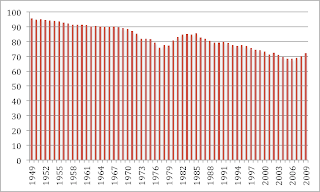These questions, and more, are central to the Washington & Jefferson College Energy Index.
In its simplest form the Index examines all energy consumed in the US and is able to provide a reliable and accessible measure of the share of this energy produced domestically. It also places our current energy situation in a historical perspective and allows for comparisons of regional differences with respect to energy consumption and production.
The chart below shows the percent of total energy consumed that was produced domestically. We see that the US produced nearly all of the energy it needed following WWII. It is also clear that as energy demands grew over time an increasing share of the energy used in the US was sourced from foreign countries. The two exceptions to this pattern of a decreasing domestic energy share are the late 1970s oil crisis and the present time period starting in the mid 2000s.
To return to our initial question - how much of the energy we consume is produced in the US - the answer currently is around three-fourths (75%). This is somewhat below the historical average but certainly is on the rise.

No comments:
Post a Comment